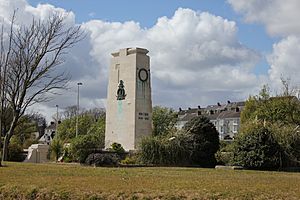Swansea War Memorial facts for kids
The Swansea War Memorial, also known as the Swansea Cenotaph, is a special monument. It remembers people from Swansea who died in wars. You can find it on the promenade next to Mumbles Road in Swansea, Wales. It looks out over Swansea Beach and Swansea Bay.
This important memorial was designed by Ernest Morgan, who was the city's architect. It looks a lot like the famous Cenotaph in London. The people of Swansea helped pay for it. They raised £3,000 for the memorial. They even had extra money, so £3,000 was used to help children whose parents had died in the war. A special stone was laid on July 1, 1922, by Field Marshal Douglas Haig, 1st Earl Haig. The completed memorial was officially revealed a year later, on July 21, 1923. Admiral of the Fleet Sir Doveton Sturdee unveiled it.
Contents
What Does the Swansea War Memorial Look Like?
The memorial is a tall, rectangular stone pillar. It's made from Portland stone, which is a type of white limestone. The pillar is about 2 meters by 4 meters wide and 9 meters tall. It stands on three steps. On top of the pillar is a stone chest. This chest is a "cenotaph," which means an empty tomb. It's a symbol to remember those who died, even if their bodies aren't there.
Details on the Memorial's Sides
The sides of the stone pillar have bronze decorations. On the two shorter sides, you'll see bronze wreaths. These wreaths are symbols of honor. Below them are the dates "1914-1918" and "1939-1945." These dates mark the years of the First World War and the Second World War.
The long side facing the sea has a bronze anchor inside a wreath. This remembers people who served in the navy. The long side facing the land shows the City of Swansea's coat of arms. It also has a Latin phrase: "Pro Deo Rege et Patria." This means "For God, King and Country."
Special Inscriptions and Stones
The very first stone laid for the memorial has an inscription. It says that Earl Haig laid it in 1922. It also mentions that Mrs. Fewings, who represented war widows, placed a King's shilling (an old coin) under it. Another inscription tells us about the unveiling in 1923.
Exploring the Memorial Area
The tall stone pillar is surrounded by an octagonal (eight-sided) paved area. This area has four entrances. There used to be gates at these entrances. Stone benches are built into the walls of this area, offering a place to sit and reflect.
Plaques Honoring the Fallen
The walls of the memorial area hold many bronze plaques. These plaques list the names of over 2,200 people from Swansea who died in the First World War. They also list 400 names from the Second World War. Some names from later conflicts are also included. The corners of these plaques have swastika symbols. At the time the memorial was built, these symbols were used as signs of good luck.
History and Changes to the Memorial
The memorial was damaged during the Second World War. Shrapnel, which are small metal pieces from bombs, hit it. Because of this damage, the gates to the paved area had to be removed. In 1994, the memorial became a Grade II listed building. This means it's an important historical building that needs to be protected.
Other Memorials Nearby
Swansea has other memorials close by. A short walk along the promenade to the east, you can find a memorial to Swansea Jack. He was a famous dog who saved many lives from the water. There's also a memorial for the Second Boer War, built in 1904. It's across from St. Helen's Rugby and Cricket Ground. A separate memorial for the Merchant Navy was put up in 2005 at SA1 Swansea Waterfront.
Images for kids
-
Swansea Jack memorial










